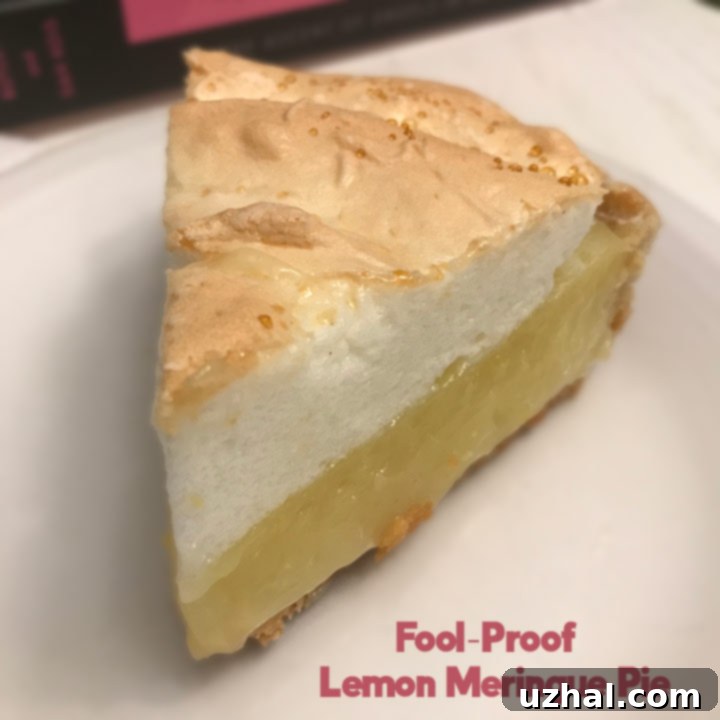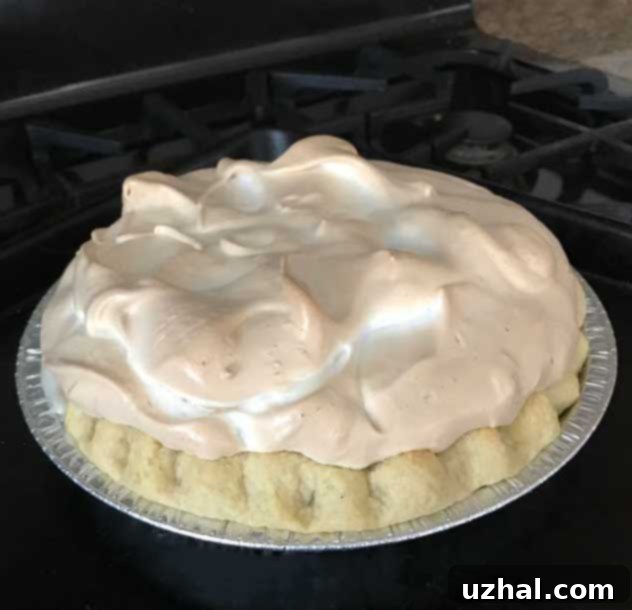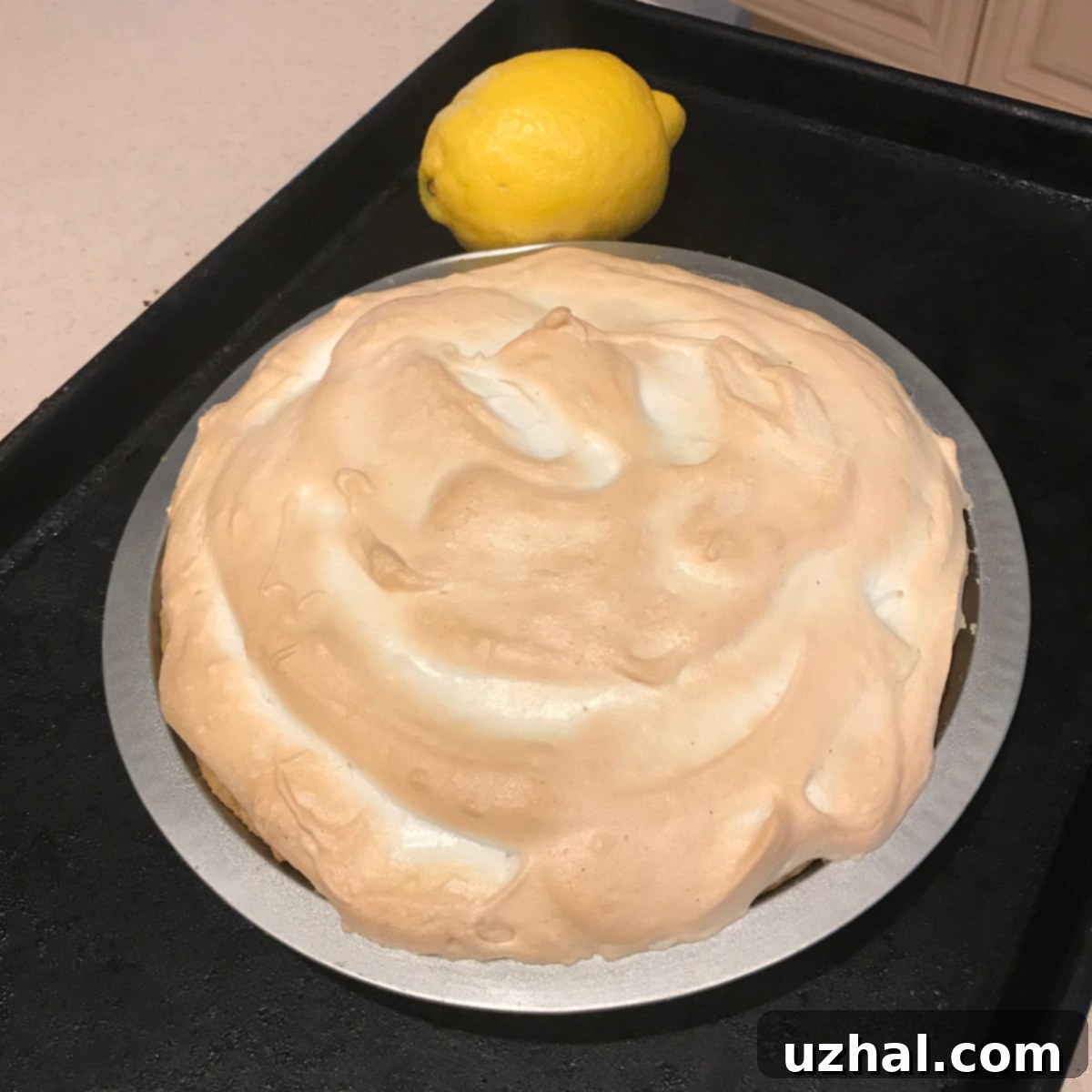Mastering the Classic: Your Fool-Proof Guide to Perfect Lemon Meringue Pie
There are some desserts that evoke a sense of timeless comfort and nostalgic joy, and lemon meringue pie undoubtedly sits at the top of that list. Its harmonious blend of tart, vibrant lemon custard, nestled in a flaky crust and crowned with a cloud of sweet, toasted meringue, is simply irresistible. However, many home bakers approach this classic with a touch of trepidation. Common pitfalls like a runny filling, weeping meringue, or a shrinking topping can turn a baking adventure into a kitchen nightmare. But what if there was a recipe that promised perfection every single time, even when minor slips occur?
Introducing the “Fool-Proof Lemon Meringue Pie” – a recipe so reliable it has become my unwavering go-to. This isn’t just a catchy name; it’s a testament to its consistent success. I’ve personally put it to the test, even making silly mistakes like completely forgetting to add the butter to the filling. Yet, even with that oversight, the resulting lemon custard remained wonderfully delicious and perfectly set, and the meringue, to my delight, neither wept nor shrank. This resilience is what makes it truly fool-proof and a must-have in any baker’s repertoire.

The Secret Behind the Fool-Proof Method: Insights from Sunset Magazine
The brilliance of this particular recipe stems from a 1997 Sunset Magazine annual. While originally published decades ago, its wisdom remains incredibly relevant and accessible today, with many of its foundational techniques still available online through a highly informative article on how to make Lemon Meringue Pie. This accompanying guide delves into the very questions that haunt aspiring pie makers: How do you prevent a lemon meringue pie from being disappointingly runny? Why is it crucial for the filling to be piping hot when the meringue is applied? And what causes meringue to shrink, leaving an unsightly gap between the topping and the crust?
This “Fool-Proof” recipe meticulously integrates the answers to these questions into its methodology. Let’s explore the scientific principles and clever techniques that guarantee a flawless lemon meringue pie:
Achieving a Perfectly Set, Non-Runny Filling
The first key to success lies in the filling’s preparation. A common issue with lemon fillings is their tendency to be too runny, a problem often exacerbated by the acidity of lemon juice interfering with starch gelatinization. This recipe cleverly circumvents this by instructing you to mix the filling ingredients – specifically the starch – first with cold water, and *then* with hot water. This gradual introduction of heat allows the starch molecules to hydrate and begin to thicken effectively before the full heat and acidity can disrupt their bonding. The result is a robust, stable custard that holds its shape beautifully once cooled, providing that satisfying, creamy texture we all crave.

Say Goodbye to Weeping Meringue
Few things are as disheartening as a perfectly golden meringue suddenly developing beads of sugary liquid, known as “weeping.” This recipe tackles weeping head-on by emphasizing the importance of applying the meringue to a *very hot* filling. The theory behind this technique is that the heat from the filling helps to immediately “set” the bottom layer of the meringue, creating a barrier that prevents moisture from escaping and turning into those undesirable droplets. The rapid setting also helps to stabilize the meringue structure, leading to a more consistent and beautiful topping.
Preventing Meringue Shrinkage
Another frequent frustration is meringue shrinkage, where the fluffy topping pulls away from the edges of the pie crust during baking or cooling. The “Fool-Proof” recipe addresses this by advocating for a lower baking temperature of 325°F. Baking the meringue at a moderate temperature allows it to cook through and brown gradually without over-coagulating the egg proteins too quickly, which is a primary cause of shrinkage. This gentle heat ensures the meringue sets firmly and maintains its volume, adhering tightly to the pie’s rim and creating a visually appealing dessert.
The Essential Foundation: A Flaky Baked Pie Crust
While this recipe masterfully guides you through the complexities of the lemon filling and the elegant meringue, it wisely focuses on these elements and does not include a recipe for the pie crust itself. The quality of your pie crust, however, is paramount to the overall success and enjoyment of your lemon meringue pie. A perfectly flaky, buttery base provides a crucial textural contrast to the smooth filling and airy meringue.
I typically prepare my pie crust ahead of time, using a tried-and-true baked all-butter pie shell recipe. Blind baking the crust is an absolute necessity for lemon meringue pie, as it prevents the bottom from becoming soggy when filled with the moist custard. If time is a concern, a high-quality refrigerated pie crust offers a convenient and perfectly acceptable alternative; just remember to bake it according to package directions before filling. The goal is a golden-brown, sturdy crust that can proudly support its delicious contents.
Tips for Ultimate Lemon Meringue Pie Success
Beyond the core techniques embedded in the recipe, a few additional considerations can elevate your lemon meringue pie from great to truly extraordinary:
- Quality Ingredients: Always use fresh, good-quality lemons for the brightest flavor. Freshly squeezed lemon juice makes a significant difference. Ensure your eggs are also fresh.
- Room Temperature Egg Whites: For the meringue, using egg whites that are at room temperature is crucial. They will whip up faster and achieve greater volume and stability than cold egg whites.
- Clean Equipment: Any trace of grease or fat in your mixing bowl or on your whisk attachment can prevent egg whites from whipping properly. Ensure all equipment is scrupulously clean and dry.
- Patience During Cooling: Resist the urge to cut into your pie too early! Lemon meringue pie needs ample time to cool completely and for the filling to fully set. Rushing this step can lead to a runny slice.
- Perfect Peaks: When beating the meringue, look for stiff, glossy peaks. This means the meringue holds its shape firmly when the whisk is lifted, and it has a beautiful sheen.
- Covering the Edges: When spooning the meringue onto the hot filling, make sure it touches the rim of the pie crust all the way around. This helps to seal the filling and further prevent shrinkage and weeping.
More Delicious Treats to Explore
If you’ve enjoyed the journey of mastering this classic lemon meringue pie, you might be interested in other delightful baking adventures. Here are some related recipes that are sure to please:
- Chocolate Chip Cookies at Their Best
- Pumpkin Cream Cheese Bars
- An Easy Lemon Meringue Pie Plus a Great Crust Recipe
- Lemon Meringue Pie with Milk
- Chocolate Pecan Meringue Cookies
Recipe

Fool-Proof Lemon Meringue Pie
Anna
Pin Recipe
Ingredients
Filling:
- 1 ¼ cups granulated sugar (250 grams)
- 6 tablespoons cornstarch (60 grams)
- ⅛ teaspoon salt
- ½ cup cold water
- 1 tablespoon grated lemon zest
- ½ cup lemon juice
- 4 large egg yolks
- 1 tablespoon butter room temperature (14 grams)
- 1 ½ cups boiling water
- Baked 9-inch pie crust
Meringue:
- 4 large egg whites room temperature
- ¼ teaspoon cream of tartar
- ½ cup granulated sugar mixed with 2 teaspoons of cornstarch
Instructions
-
Assemble all the ingredients – especially meringue ingredients. By this I mean have the egg whites in the mixing bowl and the cream of tartar, sugar and cornstarch measured and ready. This preparation ensures a smooth process, especially when the filling is hot and the meringue needs to be made quickly.
-
In a 2- to 3-quart sauce pan that is not yet set over heat, thoroughly mix 1 ¼ cups granulated sugar with 6 tablespoons cornstarch and ⅛ teaspoon salt. This dry mix forms the base for your thick, non-runny filling. Whisk in ½ cup cold water, the vibrant lemon zest, and the fresh lemon juice, blending thoroughly until smooth. Next, whisk in the 4 large egg yolks until well incorporated. Finally, add the 1 tablespoon of room temperature butter and whisk in 1 ½ cups boiling water, ensuring all ingredients are combined before heating.
-
Place the pan over medium or medium-high heat. Stir continuously with a flexible heat-proof spatula, scraper, or wooden spoon. It’s crucial to keep stirring to prevent scorching and ensure even thickening. Continue until the mixture boils, which should take about 5-7 minutes. Once boiling, reduce the heat to medium and continue to stir the filling for 1 minute more. This final minute of stirring helps to thoroughly cook the cornstarch, ensuring a stable filling. Immediately pour the hot filling into your pre-baked 9-inch pie crust and quickly proceed to make the meringue.
-
In the clean bowl of a stand mixer fitted with a whisk attachment, beat the 4 room temperature large egg whites and ¼ teaspoon of cream of tartar until the mixture is very foamy. The cream of tartar helps stabilize the egg whites. Continue to beat at high speed, gradually adding the ½ cup of granulated sugar mixed with 2 teaspoons of cornstarch, 1 tablespoon at a time. This slow addition of sugar ensures it dissolves properly and creates a stable meringue. Beat until the whites hold stiff, glossy peaks—they should stand up firmly when the whisk is lifted and appear shiny. Spoon the prepared meringue onto the hot pie filling. Using a spatula, elegantly swirl the meringue to completely cover the filling, making sure it touches the rim of the pie shell all around. This seals the pie and helps prevent shrinking.
-
Bake the pie in a preheated 325°F (160°C) oven until the meringue is beautifully browned and toasted, approximately 25 minutes. Keep a close eye on it to prevent over-browning. Once baked, carefully remove the pie from the oven and set it on a wire rack to cool completely, which typically takes about 3 hours. Allowing the pie to cool slowly and fully is essential for the filling to set and the meringue to stabilize without weeping. Serve this magnificent lemon meringue pie immediately for the freshest experience, or store it in a cake cover in the refrigerator for up to two days.
